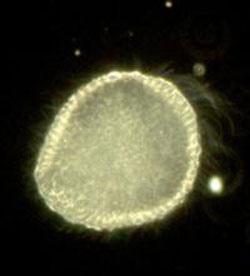Embryos tell story of Earth’s earliest animals

Sea urchins and most other animals begin their embryonic development as small clusters of cells, called blastulas. The blastulas are surrounded by a protective fertilization envelope
Purported animal embryo fossils have been reported continuously over the last 12 years, mainly by paleontologists working in China. Scientists disagree about whether the fossils are actually animal embryos or even if they are animals.
“The fossils look great. The problem is, if you know anything about embryos, their fossilization just doesn’t seem likely,” said IU Bloomington Professor of Biology Rudolf Raff, one of the report’s authors. “It’s like trying to fossilize soap bubbles. Some investigators showed that these fossils are being preserved with calcium phosphate, but they haven’t explained how embryos could survive long enough for that to happen. We do that.”
The group of scientists, led by Rudolf Raff and IUB Department of Biology Chair Elizabeth Raff, explain what conditions are most likely to facilitate the fossilization of early animal embryos, as well as what factors are not likely to affect fossilization. They used two sea urchin species as models, Heliocidaris erythrogramma and Lytechinus pictus.
“We wanted to find what conditions would allow a dead embryo to be preserved for about a month, enough time for it to be encased in minerals,” Rudolf Raff said.
The dead spherical embryos do not last long under normal seawater conditions. If the cell’s own degradation processes don’t destroy it, nearby bacteria will. The embryos must die in the presence of a so-called “reducing” substance, such as hydrogen sulfide. Such reducing substances slow or stop the internal degradation processes that occur very soon after cells die and also inhibit voracious bacteria.
Hydrogen sulfide is known to have been present in the environment half a billion years ago, at the time of the animal kingdom’s origin, and when the embryos died, because sulfur-containing pyrite (“fool’s gold”) is found in the fossils. Today, hydrogen sulfide exists in significant concentrations at the bottom of the ocean, especially in the vicinity of deep sea vents. Because hydrogen sulfide is extremely toxic (and flammable), the scientists used beta-mercaptoethanol, which exerts similar effects.
The scientists also found that embryo size does not influence the fossilization process. Sea urchin species whose animal embryos are small (a tenth of a millimeter) were just as likely to be fossilized as those of larger cousins (about half a millimeter).
“This is good news,” Raff said. “Embryo size tells us a great deal about the evolution and development of these organisms.”
The fertilization envelope, a semi-hard membrane that surrounds the urchin envelope, is crucial to the fossilization of the embryo. Without the membrane, or with a broken membrane, embryos degraded quickly. Likewise, soft-bodied larvae that hatch from the egg-like fertilization envelope did not fossilize, even under reducing conditions.
The scientists predict early animal fossils from 500 million years ago will be embryos encased in the fertilization envelope and will have been fossilized under highly reducing conditions. This suggests “biases in distribution of fossil embryos,” the scientists write, since fossils of more mature animal forms are likely to be limited, maybe non-existent.
Much mystery surrounds the sudden appearance of animals in the fossil record, between 500 and 600 million years ago. Within a few million years, the fossil record goes from zero evidence of animals to great diversity in animal forms, including anomalocarids and trilobites. Harvard University biologist and historian Stephen Jay Gould brought this “Cambrian explosion” to the popular consciousness in 1990 with his book Wonderful Life.
In 1998, Shuhai Xiao and Yun Zhang of Beijing University and Harvard’s Andrew Knoll reported in the journal Nature a stunning collection of 570-million-year-old fossils interpreted as algae and animals. Many scientists doubted the Nature report, citing a lack of evidence that something as soft as an embryo could survive long enough for fossilization to occur.
“It appears these formations in China had the conditions that would have preserved animal embryos,” Raff said. “Hopefully, the question about whether this can happen can be put to rest.”
What distinguishes animals from other organisms is the ability to ingest other organisms, either by consuming them as food, as humans do, or by digesting food externally and sucking up the aftermath, in the manner of starfish.
Media Contact
More Information:
http://www.indiana.eduAll latest news from the category: Life Sciences and Chemistry
Articles and reports from the Life Sciences and chemistry area deal with applied and basic research into modern biology, chemistry and human medicine.
Valuable information can be found on a range of life sciences fields including bacteriology, biochemistry, bionics, bioinformatics, biophysics, biotechnology, genetics, geobotany, human biology, marine biology, microbiology, molecular biology, cellular biology, zoology, bioinorganic chemistry, microchemistry and environmental chemistry.
Newest articles

How marine worms regenerate lost body parts
The return of cells to a stem cell-like state as the key to regeneration. Many living organisms are able to regenerate damaged or lost tissue, but why some are particularly…

Nano-scale molecular detective
New on-chip device uses exotic light rays in 2D material to detect molecules. Researchers have developed a highly sensitive detector for identifying molecules via their infrared vibrational “fingerprint”. Published in Nature…

Novel CAR T-cell therapy
… demonstrates efficacy and safety in preclinical models of HER2-positive solid tumors. The p95HER2 protein is found expressed in one third of HER2+ tumors, which represent 4% of all tumors….



